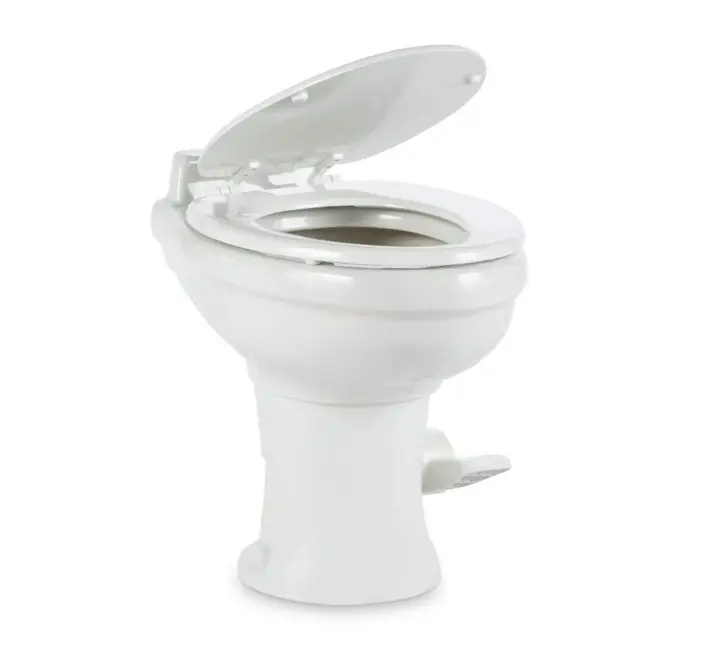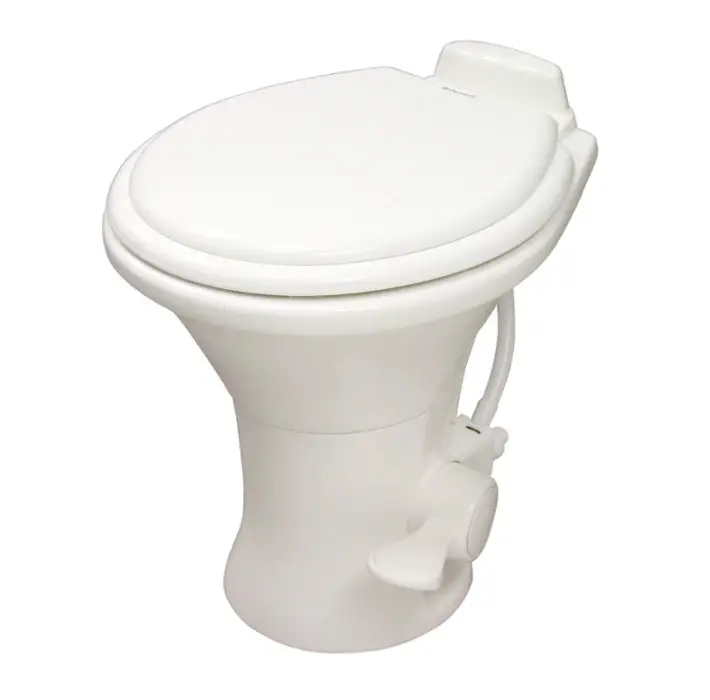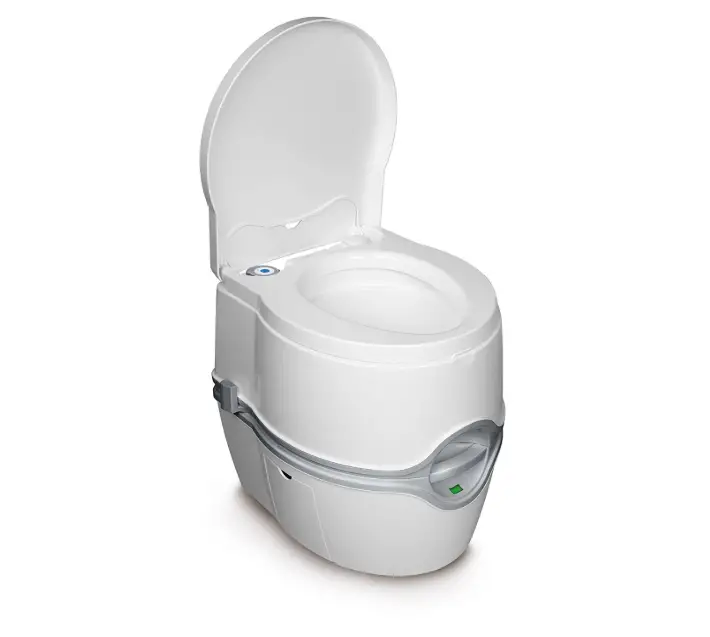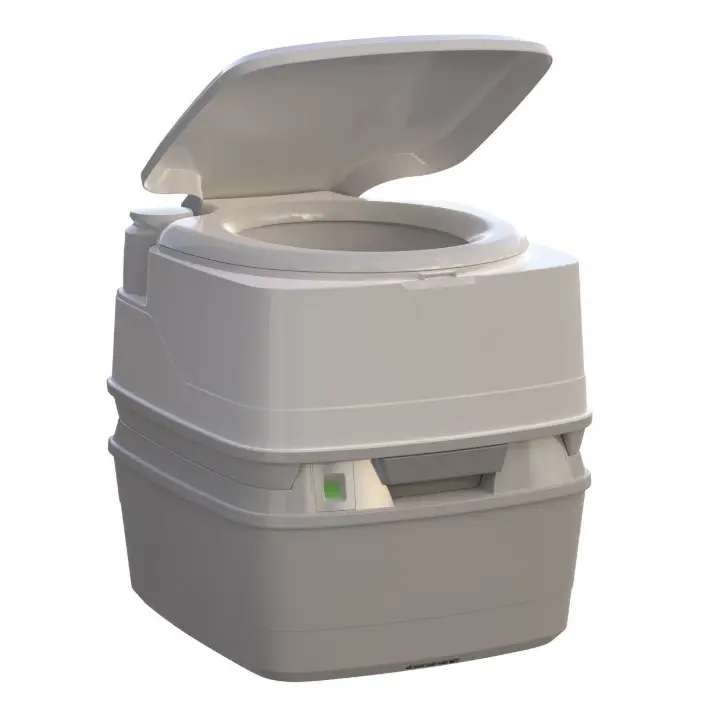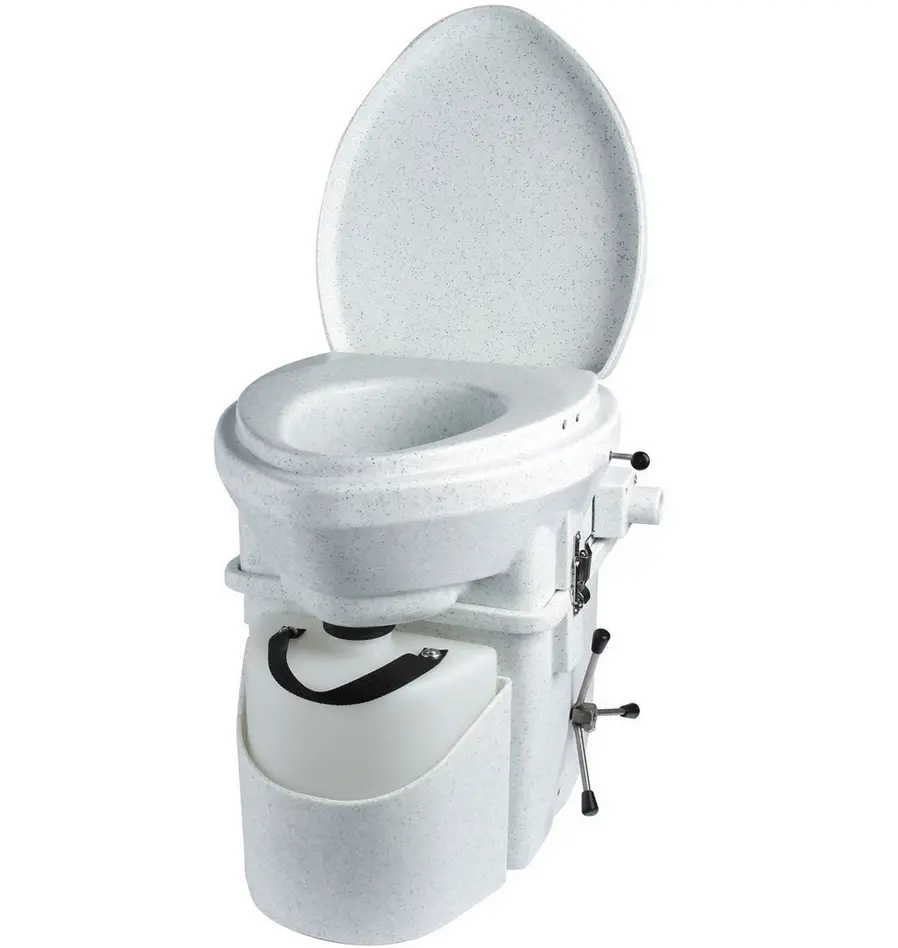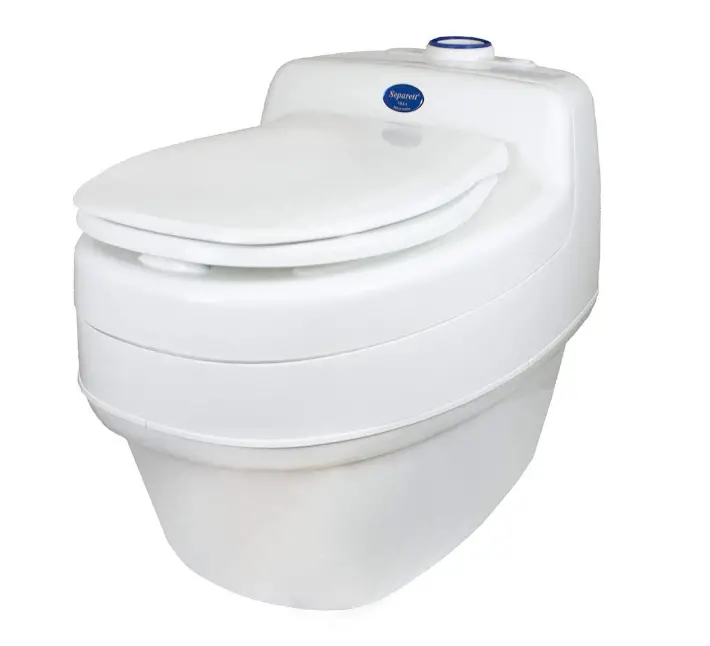
6 Best RV Toilets on the Market Today
The necessity of installing an RV toilet cannot be overestimated. Regardless of how you use your RV — sporadically or constantly, for a few hours or for long trips — it’s important to install a good RV toilet. As such, you don’t constantly have to be on the lookout for rest stops and public toilets.
However, not all RV toilets are made the same. Even though an RV toilet serves only one purpose, it’s available in many different types. There are a lot of factors you need to consider when buying one. The toilets used in RVs are somewhat different from regular toilets. They are specially designed to use less water and often doesn’t come with a flush tank as that could spill over and leak during bumps and turns.
All RV toilets serve the same purpose as regular residential toilets. However, in RV toilets, you have to be aware of the regular disposal of the septic tank contents. With most RV toilets, you’ll have to dispose of the waste in an external sewage system.
All RVs come with three water tanks.
- White Tank: where the freshwater is held.
- Gray Tank: where the kitchen water is held.
- Black Tank: where the RV toilet’s waste is held.
The black tank, meant for the RV toilets, is held under the RV and can contain as much as 90 gallons of waste, depending on the size of the tank. RV Toilets come with a pedal under the bowl. You have to engage it to flush the toilet so that the black water can go straight to the black tank. Certain chemicals are used to dissipate the odor by breaking up the fecal matter. You can also get an RV toilet with a spraying hose with which you can clean the sides of the bowl. Depending on how much you use the toilet, you must empty the contents of the black water regularly.
A lot of people are wary of getting an RV toilet, either because they think they can simply stop at public washrooms when necessary or they’re concerned about having to regularly dispose of the black water. However, there are a lot of reasons why it’s necessary to get an RV toilet.
Driving Uninterrupted
No one likes having to constantly stop while on a road trip. If you are driving as a whole family, you might find yourself stopping at washrooms quite often if you don’t have your own RV toilet. With an RV toilet installed, you never have to go around looking for public toilets.
Environmentally-Friendly
If you’re eco-conscious, you can get a composting toilet that can turn waste to fertilizer. This essentially cuts down the waste and turns it into useful compost that can be diverted into the soil.
Comfort
If you have your own RV toilet, your family will no longer have to “hold it in” while you look for public washrooms. Furthermore, you’ll be able to answer nature’s call at your own leisure and privacy.
While there are several different types of RV toilets, lets look at the 3 most common – gravity flush, portable and composting.
Table of Contents
Best Gravity Flush RV Toilets
A gravity flush RV toilet is similar to a regular household toilet. However, they don’t have a water tank at the back. To provide the water for flushing, these toilets either have to be connected to an external water source or water pump. You flush the unit using the foot pedal, and you can either pull the lever or hold it down to fill the tank. These toilets are generally made primarily of plastic, although the bowl may be porcelain.
Pros:
- Most popular type of RV toilet, hence it can easily be replaced as well.
- Uses minimal water.
Cons:
- It uses an external water supply, so it’s not ideal for a constantly moving RV or boondocking.
- A higher likelihood of the black tank clogging as it deals with fecal matter directly and little water is used.
- Can give off a foul odor.
- Disposing of waste can be difficult.
1. Dometic 320
The Dometic 320 is a porcelain gravity flush RV toilet. This is certainly a premium product and it comes at a premium price. Instead of a regular plastic toilet bowl, you get an elongated porcelain bowl. And instead of a regular toilet seat, you get an enameled wood seat. The elongated bowl adds comfort, but it also increases the toilet’s need for space. You need a clearance of about 11 inches from the floor flange to the wall at the back. Since space is an issue in most RVs, you’ll have to consider if you can spare 11 inches.
This toilet also comes with an optional hand sprayer. I highly recommend getting a hand sprayer because it helps keep the toilet bowl clean as you can spray it after you’re done. However, in most cases, you won’t need the hand sprayer because this toilet is equipped with a fully enclosed rim. When you flush, water is delivered to every inch of the toilet bowl so everything gets flushed into the tank. Furthermore, a single full-circumference flush only takes up one pint of water, so it uses less water compared to many other models.
It is also extremely easy to replace the flush ball seal. In many toilets, to replace the flush ball seal, you have to take the toilet bowl apart, which can be pretty messy in addition to being difficult. However, with the Dometic 320, you can replace the flush ball seal from within the toilet bowl itself. So it’s perfectly neat and easy.
The flush mechanism on this toilet is available as a foot pedal. It’s quite simple to operate. If you push it halfway down, you add some water to the bowl. However, if you push it all the way down, the flush ball opens up and the water and waste are flushed into the black tank. This offers optimal control over your toilet.
Pros
- The toilet bowl is an ideal height.
- Comes with a hand sprayer to clean the bowl.
- The flush ball seal can be replaced easily without disassembling the toilet.
- Has a full rim flush.
- Uses minimal water.
Cons
- Occupies more space than most RV toilets.
2. Dometic 310
The Dometic 310 is a porcelain gravity flush RV toilet that comes at a reasonable price. This RV toilet is extremely easy to install with a simple 2-bolt process. However, I personally spent a few dollars extra to replace the plastic bolts with metallic ones to secure it firmly to the RV floor. You should note that you need at least 10 inches of clearance from the floor flange if you intend on installing this toilet.
This toilet is equipped with a 360-degree vortex flush. When you flush using the foot pedal, water is released from all around the rims, making sure that every inch of the toilet bowl is covered. Furthermore, it comes with an optional hand sprayer if you want to spray away some remnant waste. Like the Domestic 320, the flush ball seal on this model can also be replaced directly from the toilet bowl, and there’s no need to disassemble the bowl.
My biggest concern with this toilet is that the flush mechanism is made of plastic and breaks easily. It worked perfectly initially. However, after a couple of weeks, it started acting up. I had to disassemble the model to remove broken pieces of plastic from the flushing mechanism. I had to replace several parts or run make-shift fixes before I realized that this model has a serious construction issue. To fix these issues, I had to attach an adhesive bumper on the floor where the flush lever makes contact with the floor, so the lever wouldn’t go down any further than it can handle.
Another common issue is that the plastic base becomes full of water over time. To rectify this, I ran a bit of silicone around the joint separating the plastic base from the porcelain bowl. Sealing that joint really helped prevent it from filling up with water and urine. You shouldn’t generally have to take such measures with RV toilets, so this is a matter of concern.
Pros
- Full-circumference flush.
- Flush ball seal is replaced easily without disassembling the toilet.
- Porcelain toilet bowl.
- Comes with a hand sprayer.
- Easy to install.
Cons
- Narrow toilet bowl.
- Toilet seat is plastic.
- Takes up considerable space.
- It’s advisable to replace the plastic bolts with metallic ones.
- Poor construction.
Best Portable RV Toilets
Portable RV toilets, also called porta pottys, are completely portable mini toilets requiring minimal installation. They take up a really small space, can be moved around easily, and come with a mini-tank attached. Furthermore, you have the advantage of using the toilet outside the RV, so there’s no odor inside.
As convenient as porta pottys can be, they have some serious drawbacks. Their holding tank is really small, so you’ll need to dispose of the waste more often than other models. Furthermore, the disposal process itself can be unsanitary. There’s no separation of solid and liquid waste, which creates awful sewage in your RV. You have to essentially carry the waste tank from your RV to the dumping ground, which means that you can both see and smell it.
Pros:
- Easy to set up.
- Can be taken anywhere.
- Does not take up much space.
- Can be used outside the RV.
- Doesn’t use much water.
Cons:
- The tank has to be regularly emptied.
- You have to see and smell the waste during disposal.
- Can be messy.
3. Porta Potti Curve by Thetford 550E
Porta Potti Curve by Thetford 550E is one of the best portable RV toilets on the market. Since this is a portable toilet, you don’t need to connect it to anything and it’s ideal for camping trips.
It has a large 5.5 gallon holding tank so it can last you at least a day or two with regular use before you have to empty the tank. It also has a fresh water capacity of 4.2 gallon, which is enough to wash the bowl clean and flush about 56 times before needing a refill.
This toilet is divided into two halves. The bottom half is the holding waste tank which is equipped with a screw cap on one side. You can connect the tube here so that the waste can be flushed out either into a dumping ground, sewage, or waste tank. To avoid any splash-back, you should engage the relief valve button before opening the waste cap. People are often concerned that emptying a porta potty is nasty business. But this portable toilet has been designed to make the process as clean as possible.
This toilet is equipped with an electric flush so you don’t have to manually flush the toilet, usually a big concern with porta pottys. However, the flushing mechanism is extremely delicate and it will inevitably break after a few weeks. Furthermore, Thetford offers a replacement mechanism for approximately the same cost as a completely fresh unit. I was quite annoyed by this because my electric flushing mechanism broke after just 2 weeks and then was rendered essentially useless. At first, I assumed I just had a faulty product. But then I realized this is an issue that most Thetford 550E users have faced.
Pros
- Comes with an electric flush.
- Has a large water tank.
- Toilet bowl is oval-shaped, spacious, and comfortable.
- Placed at an ideal height.
- Comes equipped with a toilet paper holder.
Cons
- The electric pump is not reliable and will eventually break down, rendering the toilet useless.
- Takes up a lot of battery power.
4. Thetford Porta Potti 550P
The Thetford Porta Potti 550P is a portable RV toilet with a manual pump. Depending on what you think about the 550E’s electric pump, this might be a good or bad thing. On the one hand, you have to manually flush the toilet using the piston pump. However, there’s no potential for the electric pump breaking apart and rendering your portable toilet useless. As such, the Thetford Porta Potti 550P might not be as advanced as the 550E, but it’s certainly more durable.
Beside the manual piston pump flushing system, the Thetford Porta Potti 550P is similar to the 550E in most other ways. This too has a large holding tank capacity of 5.5 gallons so you don’t have to dispose of the waste too often. Furthermore, it’s divided into a top and bottom half so you can separate the bottom part and use the screw cap to discharge the waste into another toilet or dumping ground.
This portable toilet has a sealed valve that contains all odors in the holding tank. The waste tank can also be held vertically using the ergonomic handle with which you can carry the tank conveniently without any fear of splash-back.
You should also note that this porta potty requires at least 5 inches of clearance from the rear wall. This accommodates the waste tube that comes out the back of the toilet and turns at a 90 degree angle. However, considering that 5 inches is a lot less than the clearance you need from gravity flush toilets, I’m quite happy with it.
All in all, I’m quite satisfied with this portable toilet, mostly because it’s neat and highly durable. I used it for several months while camping and backpacking and never had any issues. However, I suggest that users carefully read the instructions on how to dispose of the waste, how to flush, and generally how to handle the toilet overall. It will prove really helpful in preventing any unwarranted messes, if you know what I mean.
Pros
- Piston pump flushing system is durable.
- Large waste tank.
- Comfortable seat.
- The waste tank and its handles are ergonomically designed.
Cons
- You have to manually flush the toilet.
Best Composting RV Toilets
A composting RV toilet is one that doesn’t use any water and also separates solid from liquid waste. If you don’t have easy access to a dumping ground or water, this is the ideal option for you. Furthermore, composting RV toilets are extremely eco-friendly.
To prevent the smell of sewage, a little vent fan is used to break the odor and get rid of it. Furthermore, the use of separate holes for solid and liquid waste prevents the creation of sewage, which is the number one cause of odor.
After using the composting toilet, you need to turn the agitator that dries out the solid waste and covers it up. This contains odor while also turning the solid waste to compost. The liquid waste, meanwhile, is discharged into the septic tank.
You have to, however, limit how much you use a composting toilet. Solid waste needs enough time to dry out so it can turn to compost and not stink. As such, a composting toilet may be a good choice for a single individual, but not an entire family.
On the bright side, you don’t have to deal with black tanks at all. Plus, there are no clogged tanks, no accidental spills, nothing of the sort to worry about. You have to simply retrieve the dried out solid waste regularly and dump it. You can dispose of it in the trash, but you can also bury it in the ground where it will serve as fertilizer and enrich the soil.
Pros:
- Little water consumption.
- Limited wastewater disposal necessary.
- Power is only used for the circulating vents.
- No need to deal with black tanks.
- No clogging or spillage.
- Kitchen waste can also be disposed of in the composting toilet.
- Compost can be buried in the ground as fertilizer.
- Eco-friendly.
Cons:
- Can only be used for an individual or two people. If there are too many people, or used too frequently, you’ll have to dispose of the solid waste more often.
- Doesn’t work very efficiently in cold climates since the solid waste needs to dry.
- Can be unpleasant if you’re not careful.
5. Nature’s Head Dry Composting Toilet
The Nature’s Head Dry Composting Toilet is widely considered to be the best composting toilet on the market. It’s sturdy, well designed well, and reliable. However, the best part about this imposing toilet is its ease of installation, considering composting toilets have a notorious reputation for being difficult.
I was impressed that this toilet is completely odor-free. You don’t experience any odor either from the toilet bowl or from the compost deposit. It has a screen in place to block out odors. Furthermore, it is lightweight and highly durable; I used it for over a year and never had to repair or replace any of the parts.
However, the most impressive part of this toilet is the dry composting mechanism. All the liquid in the toilet is diverted into different chambers so the compost is completely dry. Most noxious sewage odors are caused by the water and solid waste mixing together. By keeping the compost dry, the whole process of decomposition is made smoother, more hygienic, and completely odor-free. Even emptying the solid tank is not an issue because you don’t have to worry about any messy splashes, and the waste looks and smells like plain dirt.
If you don’t know what to do with the waste, you can consult the manufacturer’s complementary Humanure Handbook. A number of different methods are described in depth on how to handle human manure and dispose of it sustainably. If you’re an environmentally conscious individual, you could really benefit from this.
This composting toilet hardly has any flaws at all. If I were to get super nit-picky, I might say that the toilet could have been a little higher. As it currently stands, I had to bend my legs quite a bit to accommodate myself. But that’s an extremely minor issue.
Pros
- Completely odor-free.
- Durable and lightweight.
- Efficient dry composting system.
- Waste is completely dry with no potential of creating a mess.
- Easy to dispose of waste.
- Comes with a helpful handbook on sustainable waste disposal.
Cons
- Toilet could have been slightly higher.
6. Separett Villa 9215
The Separett Villa 9215 is a completely waterless composting toilet that’s also incredibly expensive. It’s designed a lot more aesthetically than the Nature’s Head composting toilet mentioned above. Besides that, it works much the same as the Nature’s Head with only one major difference in regard to liquid waste disposal.
This is a low-profile RV toilet with a unique liquid waste disposal system. In most composting toilets, the urine and liquid waste are directed to a liquid tank which you have to regularly empty. However, in this case, the liquid waste is directly piped outdoors. As such, you need to divert it into a drain pit. If you’re on the move, you can get an external grey water tank and divert the liquid waste into that.
The inside of the toilet bowl also comes with a weight-triggered trap door. The moment you use the toilet, the trap door is engaged and your waste escapes, so you don’t even have to see the worst of it. When you stand up again, i.e., when the weight is released, the trap door closes again. This is a pretty interesting solution to flushing and it doesn’t require any water use.
The composting process happens in a removable bin that can be lined with a disposal bag. When you’re ready to dispose of the solid waste, simply remove the bag and get rid of it. There’s no odor and no sight. It’s the most hygienic means of getting rid of your waste.
There are no serious drawbacks to this composting toilet. Some people might not like that they have to potentially use a separate tank for the liquid waste, but others might appreciate that it can directly be diverted to a sewage pipe. The only big complaint here is that it’s way too expensive, much more so than the almost identical Nature’s Head composting toilet.
Pros
- Attractive design.
- Compost is held in a disposal bag-lined bin. Thus, easy to get rid of the compost.
- Weight-activated trap door is an ingenious mechanism for flushing.
- Liquid waste can directly be diverted to a sewage drain so you don’t have to deal with it.
Cons
- Way too expensive.
- If you’re on the move, you’ll need to use a separate grey water tank for liquid waste.
What are Other Types of RV Toilets?
Macerating RV Toilet
Macerating RV toilets use a rotating blade system to turn fecal matter into liquid slush before it is diverted into the black tank.
In this case, the black tank can be located far from the toilet, and there is little chance of clogging because it receives fluid slush only. Furthermore, it will also become easier for you to discharge the waste. Since tanks are located far from RV toilets, you don’t have to worry about odors as much.
The only drawback here is that macerating RV toilets can be quite expensive.
Pros:
- Tank can be far from the toilet.
- Easier to dispose of waste.
- Minimizes risk of tank clogging.
- Odors are reduced.
Vacuum Flush RV Toilet
As the name suggests, Vacuum flush RV toilets create a vacuum in the toilet using a stored vacuum vessel. The vacuum pulls the effluence from the toilet and a macerating vacuum pump then breaks down the matter before it ends up in the black tank. In this case, the black tank can be located far from the toilet, so it doesn’t produce as much odor. Furthermore, since they rely on a vacuum pump to pull the waste, they are extremely water-efficient.
Pros:
- Little to no water is used.
- The black tank can be far from the toilet.
- Minimal odor produced.
- Fecal matter is broken down so the tank doesn’t clog.
Cons:
- Complicated to set it up.
Cassette RV Toilet
Cassette RV Toilets are similar to portable toilets, except they are fixed in one place and the black tank is accessed from outside the RV. You will need to get close to the waste tank to dispose of waste, so it has some of the same drawbacks as porta pottys. They are best used for small RVs and vans.
Pros:
- Takes up less space.
- Uses little water.
- Waste tank can be removed and cleaned externally.
Cons:
- Waste tank is small so frequent disposal is needed.
- Can be messy.
Factors to Consider when Buying an RV Toilet
Once you decide which type of RV toilet you need, you should consider the following factors.
Hygiene
Hygiene and sanitation are naturally important concerns when it comes to handling RV toilets. Choose an RV toilet that flushes well and doesn’t leave waste behind on the bowl. It shouldn’t be designed in such a way that there are leaks as they can spread bacteria around in your RV.
Furthermore, hygiene also depends on the disposal method. Some RV toilets — like the porta potty — require you to physically dump out the waste tank. And some come with a covered black tank that ensures limited or minimal spillage.
Installation
You will be handling your RV on your own, wherever you go. It’s likely that you might have to fix or install the toilet repeatedly for a number of reasons. As such, make sure that it’s easy to install without professional help. Generally speaking, smaller portable RV toilets are the easiest to install and fix. But they’re also messier than most. So select a toilet with a good balance of simplicity and hygiene.
Features
Before purchasing an RV toilet, examine all the features. Make a checklist of those you need and make sure they are available. For example, one of the most important features is that the waste should be covered so you don’t have to see it. Another important feature is the presence of a vent to dissipate odor.
Water Use
Some RV toilets are more water intensive than others. Depending on where you are, you might not have access to a lot of water. So choose an RV toilet accordingly. RV toilets like the vacuum flush toilet and compost toilets require minimal water.
Comfort
Your RV toilet should be comfortable to sit on and use. It should also be comfortable in terms of dumping the wastewater and cleaning. In terms of comfort during use, make sure the seat is made of good material and the height is ideal. You can replace plastic seats with enameled wood as they are more comfortable. Some toilets come with remote flush systems that can be useful if you’re using the toilet in the dark.
Duration of Trips
The duration of your trip is an important factor in determining the type of RV toilet to get. If your trips are short, you can get a cassette or porta potty RV toilets as they can be easily installed and you can quickly get rid of the waste. However, if you’re traveling for long periods and with family, you need a proper toilet with a large holding tank, for example, a gravity flush or macerating toilet.
Number of Users
Similar to the previous point, the number of users will determine the type of RV toilet you should get. For example, a composting toilet or porta potty is ideal for a single individual who doesn’t use the toilet too often. However, if you’re traveling with a family, you’ll need a gravity flush or macerating toilet connected to a black tank of over 50 or 60 gallons.
Space
Consider how much space is available in your RV. If you have a small space for the toilet, you should get a small cassette model with a 360-degree bowl-to-base rotation. Even though they are a bit uncomfortable, you should go for low-profile RV toilets so they fit into available space.
Additional Factors
Different toilets come with additional features that might not be necessary, but can be useful. These features can include additives to break the odor, hand sprays to clean the bowl, etc. Try to find a toilet that has these additional features as they will make your life a lot easier.
How to Handle Toilet Odor
If you experience a bad odor in your RV, then the holding tank is likely located close to the toilet. This is usually the case with gravity flush models. When the waste tank is located close to the toilet, the sewage odor rises up the toilet and into the bathroom, eventually stinking up the entire RV.
To dissipate the bad odor, you can take a couple of measures:
- Make sure the toilet bowl has enough water to dissipate the smell of sewage.
- Use tank treatment solutions and chemicals to break down the smell.
- If the smell persists, consider switching to a macerating or vacuum RV toilet.
Is it Safe to use Toilet Paper in RV Toilets?
You should only use specific RV toilet paper in RV toilets. These papers are specially designed to easily break down and disintegrate so they don’t clog up your holding tanks. If you use regular paper, it will likely clog up the tank and you’ll have a real messy time cleaning and disposing of the tank’s contents.
If you don’t find specific RV toilet paper, you can even use one-ply toilet paper. They disintegrate fairly easily. However, it would be best to dispose of them in a separate basket instead of flushing them. Disposing of toilet paper in wastebaskets will also ensure that the holding tank doesn’t fill up too fast. Thus, you won’t have to dispose of the tank’s contents too frequently.
Conclusion
I hope this article has helped you decide which is the best RV toilet for your needs. As you can see, there are a lot of great options to choose from. Should you use a gravity flush RV toilet? A composting toilet? Or a portable toilet? You can consult our Buyer’s Guide for a detailed overview of your options.
Now that you’ve selected the best RV toilet, it’s time to hit the road in a hygienic and sanitary manner!



